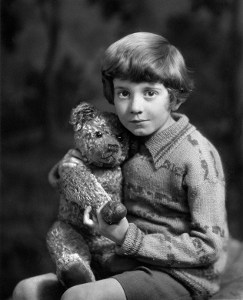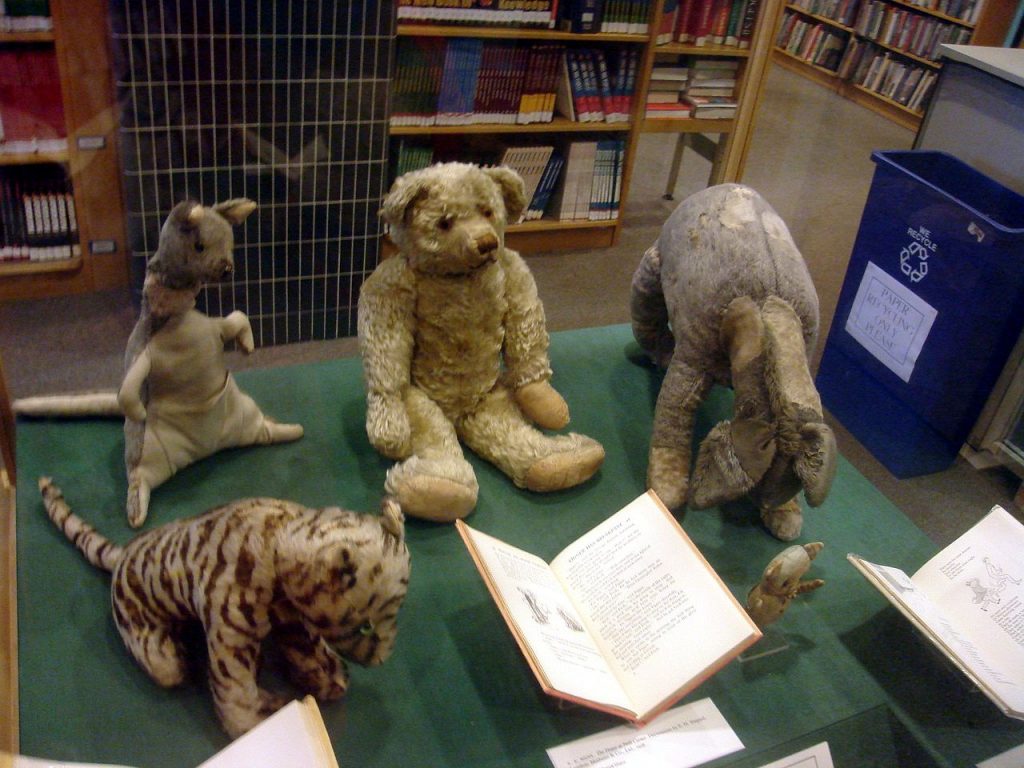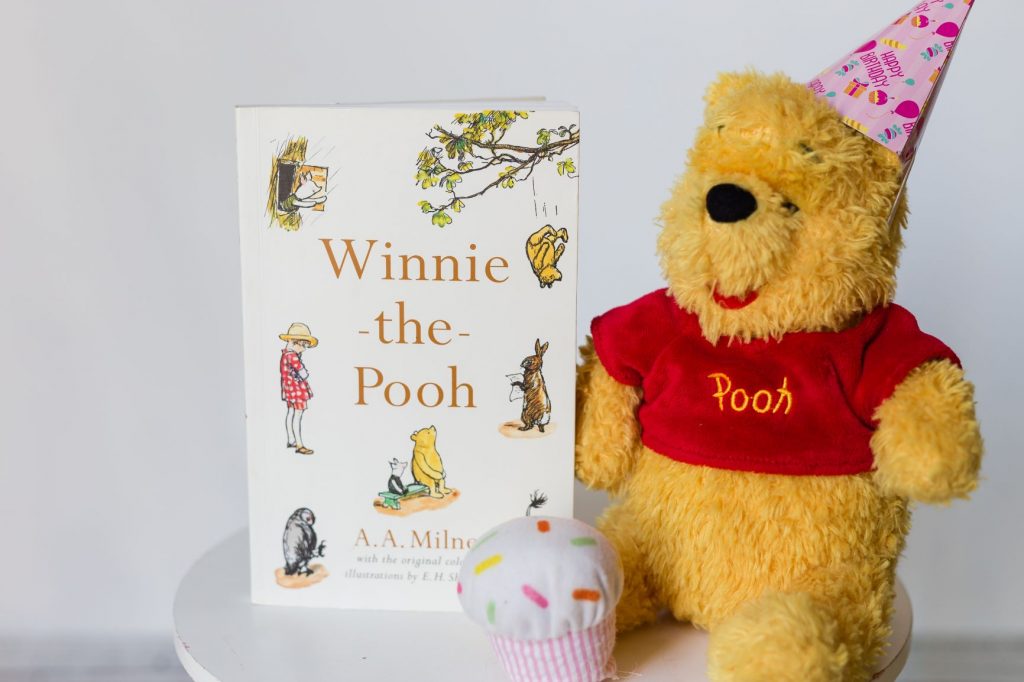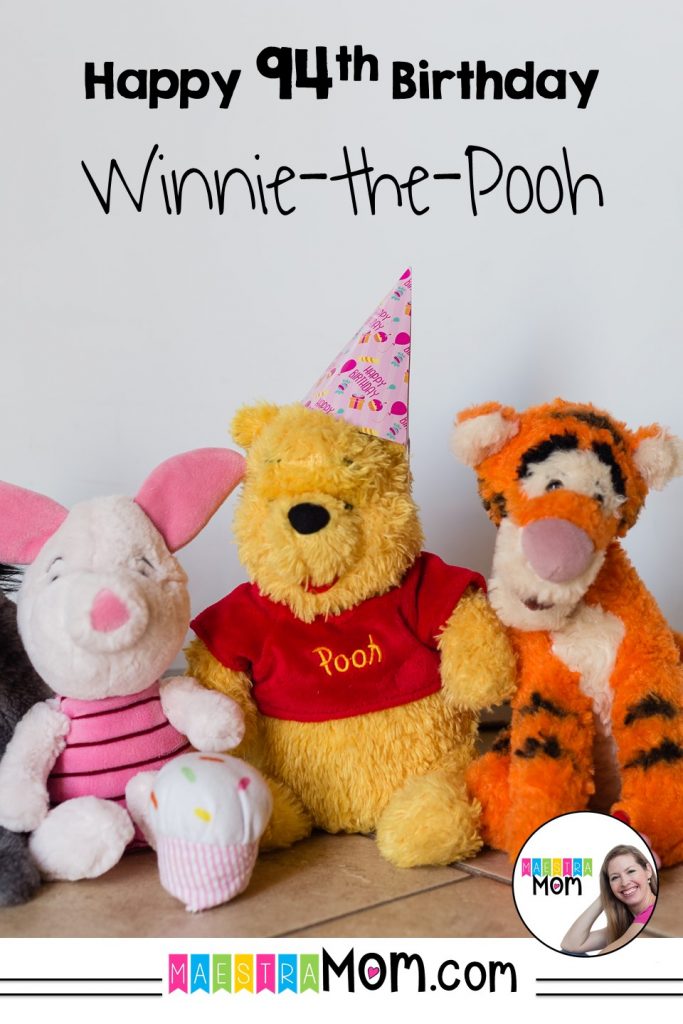Almost 100 years ago, on October 14, 1926, Winnie-the-Pooh hit bookshelves everywhere and almost instantly became the world’s most beloved bear. This Bear of Very Little Brain captured the hearts of children and adults alike with his innocent, common-sense loyalty and fun!
By the time my children came along, the Silly Old Bear was a household name. My daughter quickly acquired a stuffed Pooh. She saw the cartoons on TV, rode the Pooh ride at Disney World, and we had several modern picture books and videos featuring the “Tubby little cubby all stuffed with fluff” and his friends in the Hundred Acre Wood.
But it wasn’t until we decided to read her the original books by A.A. Milne that we fell in love with Pooh for ourselves.
Who is this Bear of Very Little Brain?
Here are 7 quirky facts about the irresistible little yellow bear:
1. Winnie the Pooh was a real teddy bear – and a real bear!
Author A.A. Milne modeled the Winnie-the-Pooh storybook character after his son’s golden-haired teddy bear, Edward Bear. Bought for him when he was little, his son renamed the bear Winnie after visiting the famous Canadian black bear of that name gifted to the London Zoo. While on holiday, they also saw a swan named Pooh. The little boy put the two names together and Winnie-the-Pooh was born.
2. Christopher Robin was a real child and the book characters were his childhood toys
A.A. Milne’s little son was actually named Christopher Robin. He loved stuffed animals and often imagined grand adventures with them. Among his favorites were a golden-haired bear named Winnie-the-Pooh, a piglet, a donkey, two kangaroos, and a striped tiger. These original stuffed animals can be seen on display at the Main Branch of the New York Public Library in New York City. Well, all except little Roo who was unfortunately lost in the 1930s. In the most recent Pooh movie in 2017, Goodbye Christopher Robin, the characters were modeled anatomically after the real Christopher Robin’s actual stuffed animals.

3. The Hundred Acre Wood is a real forest
The year before the book was published, the author bought a country home a mile north of Ashdown Forest. This lovely forest is situated 30 miles south-east of London and so A.A. Milne, his wife, son, and son’s nanny would spend weekends there and a month or two in the spring and summer. In his autobiography, Christopher Milne shared, “Pooh’s forest and Ashdown Forest are identical.” Many of the place names in the books are adaptations of the real names within the forest. Pooh fans have even been known to make their way through the forest using only a map of the Hundred Acre Wood from the books!
4. All of the characters in the Winnie-the-Pooh series are boys, except Kanga
Interestingly, all of the characters in the stories are boys except one. Kanga is the lone female and acts as the mother figure of the group. A.A. Milne added the Owl and Rabbit characters to the stories from his own imagination. When Disney bought the rights to the stories after Milne’s death in 1956, they added the character of Gopher, who is also a boy.

5. A.A. Milne went to college to study mathematics and instead became a world-famous author
Alan Alexander Milne went to Cambridge to study mathematics! However, he always had a love for writing and became a well-known playwright before writing the Pooh stories that made him famous. Interestingly, he even wrote a stage adaptation of another beloved kids classic, The Wind in the Willows. Overall, he penned 18 plays, 3 novels, short stories, and poems but is most revered for bringing us Winnie-the-Pooh.
6. No one can explain the mystery of Mr. Sanders
No one can quite explain satisfactorily why Pooh lives in a tree-house with the name Mr. Sanders written on a plaque above the door. Some have speculated that Sanders could be Pooh’s last name. Others call that hogwash and insist the author wanted to honor his publisher friend by the last name of Sanders, although he is not the one who published the books. A.A. Milne reveals about the name Sanders, “”It means he had the name over the door in gold letters and Pooh lived under it.” And that’s about all we really know about that.
READ: Classic 1st Grade Books for a New Generation
7. Pooh didn’t always have a red shirt
The Pooh stories, Winnie-the-Pooh in 1926 and The House at Pooh Corner in 1928, were originally illustrated in black and white pencil sketches by E.H. Shepard. Pooh did sometimes wear a shirt in the originals – and sometimes not. He first appeared in color in 1932 when Stephen Slesinger colored him wearing the iconic red shirt that he is known by today for an RCA Victor picture record.

Happy Birthday, Silly Old Bear!
When our oldest daughter was just 5 or 6, my husband had been reading aloud to her from the story of Winnie-the-Pooh and then The House on Pooh Corner. The last chapter of the story, when Christopher Robin was going away – and nobody knew where he was going or why – my husband emerged from the hallway with tears in his eyes.
“She’s growing up!” he cried! “It’s all going to end! She won’t be ours forever. Ah! How can a kids story ambush me like this!”
As almost 100 years ago, still today A.A. Milne has a magical way of touching our hearts and making a complicated world simple and innocent – even for those of very little brain.
Your kids will be growing up soon. Stop and read them some Pooh.



This is a great post! Love it.
Thank you! There’s so much to love about Winnie the Pooh!
Pingback: Best 4th Grade Books List for Teachers & Parents - Maestra Mom